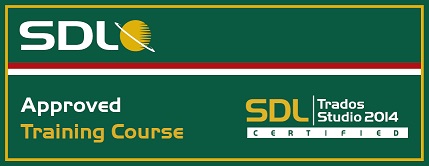SDL MultiTerm 2014 for Translators and Project Managers
Course summary
SDL MultiTerm 2014 for Translators and Project Managers Learning Objectives: This course is designed for users who want to get familiar with SDL MultiTerm 2014 quickly and start working productively from day one. - Introduction to basic terminology concepts - Overview of the application - Performing look up operations in a termbase - Defining filters - Creating termbases from scratch - Converting existing glossaries in MS Excel format for use in SDL MultiTerm - Adding entries to the termbase - Creating input models - Leveraging legacy documents to fill your termbase using terminology extraction - Accessing termbases from SDL Trados Studio - Exporting termbase content to tables and printable dictionaries - Overview of SDL MultiTerm Online Target Audience: - translators and project managers who have never used SDL MultiTerm 2014 before and want to get started with the application to be productive from day one - translators and project managers who are already using SDL Trados Studio 2014, and want to learn more on SDL MultiTerm to enhance their translation process by leveraging terminology Prerequisites: Basic understanding of PCs, the Windows operating system and MS Word. SDL TRADOS Certification: This course provides all of the knowledge attendees need to pass their SDL MultiTerm 2014 exam The SDL Certification program enables individual translators and project managers to validate their knowledge and expertise in the use of SDL MultiTerm products. Achieving SDL MultiTerm Certification demonstrates that you are fully prepared to work with the world’s leading translation technology. Certification in the SDL MultiTerm 2014 product can be achieved by taking the following web based exam: - SDL MultiTerm 2014 The exam questions are based on the topics covered in the corresponding SDL MultiTerm 2014 course. Attendance on this course followed by practical experience of the topics covered will prepare attendees to take the exam. Attendees will be advised on completion of their exam whether they have passed or need to retake. Further Development: At the end of this course attendees will have covered all of the topics necessary to significantly increase translation speeds and productivity. Attendees should also consider attending the following courses: - SDL Trados Studio 2014 – Getting Started Part I and 2, which will help you get familiar with the product and start translating documents productively from day one - SDL Trados Studio 2014 – Intermediate, which will teach you to go beyond the basics for more effective handling of translation projects - SDL Trados Studio 2014 – Advanced, which help will translators and project managers to leverage advanced functionality to get the most out of the product - SDL Trados Studio 2014 for Project Managers Part 1 and 2, which will help you to work productively from as a project manager day one See upcoming courses here. Further Information: For further information on any of our courses, training delivery options and course dates, the SDL Certification programme or course fees please contact us at contact us TOPICS COVERED DURING THE COURSE Introduction • Basic concepts: • What is terminology? • What is a termbase? • What does concept-oriented mean? • Scope of SDL MultiTerm Getting started • Starting SDL MultiTerm and opening a termbase • User interface overview Searching a termbase • Browsing through the termbase entries • Normal search • Fuzzy search • Full-text search • Searching a termbase from any other application through the SDL MultiTerm Widget • Filtering in a termbase • Limiting your searches to a subset of the termbase entries • Simple and advanced filters • Opening another termbase: multiple termbase search Quick termbase creation • Creating a termbase using a template • Modifying the template by adding an extra information field (e.g. Subject) • Converting an existing glossary from MS Excel into SDL MultiTerm XML format • Importing the converted glossary into the empty termbase Creating a new termbase from scratch • Adding languages (indexes) • Adding information fields (descriptive fields) • Defining the termbase structure Adding entries to a termbase • Adding a new entry to the termbase • Streamlining the entry creation process through input models • Terminology extraction: using legacy documents to fill your termbase quickly • Setting up a bilingual term extraction project • Running the term extraction • Checking the extraction result • Exporting the extraction result to your termbase Using SDL MultiTerm from SDL Trados Studio • Selecting a termbase • Using active terminology recognition to insert terms into your translation quickly • Searching a termbase from SDL Trados Studio • Adding termbase entries on the fly while translating • Adding the term pair • Adding a descriptive field (e.g. a Subject field value) • Saving the entry to the termbase Exporting termbases • Full export (for backup purposes) • Partial export based on a filter • Exporting to tabular format (2-column, bilingual term list) • Exporting to a printable RTF format SDL MultiTerm Online - overview • Scope of SDL MultiTerm Online - publishing terminology to make it available to a broad audience • Logging in to SDL MultiTerm Online • Searching a termbase within your Web browser Registration and payment information (click to expand) Click to expand Click on the buy button on the right to purchase your seat Participation fee includes: • Access to training session with SDL Trados Certified Trainer. • SDL Trados Approved Training Manual & sample files for practice. • SDL Trados Certification Exams. Steps to take your training and certification: 1 - Register & Pay To register in this session please click on the "register and pay later" button on the right. Your status will be marked as "registered" and it will indicate only your interest in the training session. Status changes to registered and paid when payment is processed and informed to ProZ.com. To purchase your seat at this session please click on the "buy" button. Available slots are limited and will be assigned to registered and paid participants as soon as payment is reported. Early payment is advised in order to secure participation. Allow some time for payment processing if you are paying by wire transfer. There needs to be a minimum of 6 students to conduct this training session. If the minimum of paid students is not reached 72 hours before the session is to take place, you will be notified and asked to book your seat in an upcoming session without extra cost or transaction from your part. Participants should not delay in making payments to ensure classes are not canceled due to low enrollment. We suggest then you purchase your spot as soon as possible. If you have purchased training with SDL Trados or as part of a software + training offer you should redeem your credit by clicking on the "use credit" button on the right. More information about training credits is available here. After your payment is received, your status will be changed to “registered and paid” and your spot for the session will be secured. An invoice and receipt of payment will be sent to you for your records. 2 - Get your course manual and sample files After payment you will be given access to a restricted area of the site to download the courseware and sample files. You don't need to have gone through the manual and files before the training, and ideally should not have them open during the session. Your instructors will be sharing their screen and using the sample files. The manual and files are so that you may practice after the training and prepare to pass the certification exam. Some of the sample files will be proprietary SDL Trados files and can only be opened with an installed activated license of SDL Trados. 3 - Attend the training session 72 hours before the training session takes place, you will receive an invitation to join the session. Please, click the registration link or button provided in the invitation email to join the session at the announced time. Note: three hour online SDL Trados sessions are not recorded. 4 - Take your SDL Trados Certification exam SDL TRADOS Certification exams are delivered by SDL TRADOS. Certification exams will be available in your SDL My account approximately 10 working days after making a payment. Note that you must be registered and have an account at SDL to receive the certification exams. If you do not have an account with SDL, you can create one here: https://oos.sdl.com/asp/products/ssl/account/ Make sure you use the same email address associated with your ProZ.com account when creating your SDL account. If you have an account with a different email address, or if after 10 days you have not received the certification exams please contact SDL Product training at [email protected] indicating which training session you have taken along with the proper email address for your SDL account so that the certification exams can be updated. Please follow the below instructions to access training materials and exams in your sdl.com account: Log onto your SDL My Account area on the following link https://oos.sdl.com/asp/products/ssl/account/ and go to the Certification and Training page, where you will find the Workbook and sample files for you to download. You will also find 3 attempts at your exam which can be taken at any time online, and will not expire. If you cannot locate training materials at sdl.com, submit a support request and report an email address associated with your sdl.com account. Please, read the SDL Certification Training Sessions FAQs for more information Software and system requirements (click to expand) Click to expand Software Virtual platform system requirements For PC-based Users • Required: Windows® 8, 7, Vista, XP or 2003 Server • Required: Internet Explorer® 7.0 or newer, Mozilla® Firefox® 4.0 or newer or Google™ Chrome™ 5.0 or newer (JavaScript™ and Java™ 1.6 or higher recommended) • Internet Connection Required: Cable modem, DSL or better recommended • Required: Minimum of Pentium® class 1GHz CPU with 2 GB of RAM • Dual-core 2.4GHz CPU or faster with 2GB of RAM (recommended) For Mac®-based Users • Required: Mac OS® X 10.6 or later • Required: Safari™ 3.0 or newer, Firefox® 4.0 or newer or Google™ Chrome™ 5.0 or newer (JavaScript™ and Java™ 1.6 or higher recommended) • Internet Connection Required: Cable modem, DSL or better recommended • Required: 2.4 GHz Intel processor (Core 2 Duo), 1 GB of RAM or better For iPad®-based Users • Required: iPad® 1 or newer; iPhone® 3GS or newer; iPod® Touch (3rd generation) or newer • iOS 4.2 or newer • WiFi recommended for VoIP • Free GoToMeeting App from the App Store For Android-based Users • Android 2.2 or higher • 1Ghz CPU or higher recommended • WiFi recommended for VoIP • Free GoToMeeting App from the Google Play Store To Use VoIP (mic & speakers) • Required: Fast Internet connection (700Kbps or more recommended) • Required: Microphone and speakers (USB headset recommended) Attendees who join the audio portion of a webinar are joined muted by default. This is done to reduce echo, static, feedback and/or noise during the webinar. Courses will be open half an hour before the start time. Please login before the start time to ensure that everything on your system is working correctly. Created by General discussions on this training
To report site rules violations or get help, contact a site moderator:
You can also contact site staff by submitting a support request » This discussion can also be accessed via the ProZ.com forum pages.
| Course registration To view pricing and payment options for this course, you must login to your ProZ.com account. Do you have any questions about ProZ.com training? Read the training FAQ » Still need help? Submit a support request » Would you like to share your thoughts about the ProZ.com training platform? Click here to discuss this feature in the forums » | |||||||||||||||||||||||||||||||||||||||||||||||||||||||||
You have native languages that can be verified
You can request verification for native languages by completing a simple application that takes only a couple of minutes.
Review native language verification applications submitted by your peers. Reviewing applications can be fun and only takes a few minutes.
View applicationsYour current localization setting
Deutsch
Select a language
Close search



.png)


